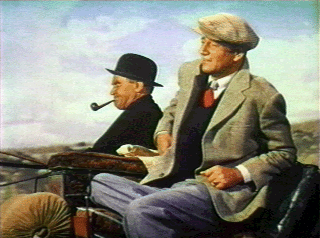The Quiet man

In late 1951, as his film The Quiet Man was being edited into final form, director John Ford sent a cautiously optimistic telegram to his friend Lord Killanin in Dublin: "The Quiet Man looks better and better. There is a vague possibility that even the Irish will like it." Though The Quiet Man would be enormously popular in America, its portrait of rural Irish life in the 1920s striking a chord of deep sympathetic response among moviegoers of all religious and ethnic backgrounds, Ford's hopes for a similar response in Ireland were in vain.
"It was not very popular here at first," Killanin would recall years later, "and there were strong objections to the line from May Craig, Here's a fine stick to beat the lovely lady'." Initially, as Killanin's remark suggests, it was the film's portrayal of the tempestuous relationship between Sean Thornton (John Wayne) and Mary Kate Danaher (Maureen O'Hara) that met the strongest resistance. "To this day," says Margaret Niland, a local woman who was there when The Quiet Man was filmed in County Mayo, "I still don't like that bit where he drags her across the fields. . . . That scene is not so nice because I think it does the Irish down."
Today, it is The Quiet Man's picture of a premodern or preindustrial Ireland--an older society of dowries, cattle fairs and donnybrooks--that more often draws the objections of Irish commentators. A common move is to portray Ford's image of Ireland--"a never-never Golden Age," as Harlan Kennedy describes it, "a time of simple pastoral integrity"--as a mode of cultural imperialism, with Hollywood perpetuating various Irish stereotypes whose origins lay in long centuries of English political domination. Along with outright falsity, remarks James MacKillop, the sins attributed to The Quiet Man include "sentimentalism, condescension, clich‚ and gimcrackery."
Taken together, Kennedy argues, such qualities add up to a view of "Irishness" that is "not less patronizing and oppressive than the collar-and-lead colonialism long exercised by Britain." In recent years, as Irish Studies has attempted to make a place for itself in an Anglo-American postcolonial discourse driven by identity politics, this has become more and more the standard line. Thus, for instance, Lance Pettitt's recent Screening Ireland approaches The Quiet Man from a perspective deriving less from film study or Irish history than from the "postcolonial" theorizing of such writers as Homi Bhabha, Gayatri Spivak, Ania Loomba, and Edward Said.
In Ireland, a sense that American cinema represents a threat to Irish cultural independence is nearly as old as the republic. "We cannot be the sons of Gael and citizens of Hollywood at the same time," wrote one Irish nationalist in the 1930s. This is the spirit in which so much contemporary Irish filmmaking has defined itself specifically in opposition to The Quiet Man's image of Ireland as, in Luke Gibbons's phrase, "a primitive Eden, a rural idyll free from the pressures and constraints of the modern world."
The truth about Ireland is therefore to be sought in the bleak social reality that The Quiet Man's pastoral idyll hides from sight, as in what Terry Byrne describes as the "mind-numbing and desperately depressing" existence of the characters in Joe Comerford's Traveller (1978), or the rural poverty portrayed in Pat O'Connor's The Ballroom of Romance (1982), or the squalor of the Dublin squatter society--drug addicts, dealers, prostitutes, pimps--in Cathal Black's Pigs (1984).
Even a commercially successful film like Roddy Doyle's The Commitments (1991) is taken to provide a modicum of truth in what might be called the Corpo flat realism of the scenes taking place in Dublin's public housing projects: "an alternative body of imagery," as Gibbons calls such material, that can be seen as addressing "the realities of Irish life."
As Gibbons's phrasing suggests, his sympathies are on the side of the new Dublin realists against what he describes as the straitjacket of stereotype. Yet Gibbons has also, virtually alone among Irish commentators, grasped the sense in which The Quiet Man has for nearly fifty years been serving as a mirror for Irish cultural anxieties, provoking reactions having very little to do with the film itself. His essay "Romanticism, Realism and Irish Cinema," which goes some way toward taking The Quiet Man seriously as a work of the artistic or cinematic imagination, anticipates several points I want to make in this essay.
Nonetheless, my attempt will be to get entirely beyond the matter of "alienating images" of Ireland, as Gibbons calls them. For my argument will be that John Ford saw in "Ireland" something like the imaginative resource that Yeats found in Irish myth--"a symbolic language," as Yeats himself once puts it, "reaching far back into the past"--and that The Quiet Man is far closer to Shakespearean romantic comedy, and to the premodern world of village festivity and pagan ritual we glimpse in its immediate background, than to anything in recent Irish culture.
My argument will be, ultimately, that the power of The Quiet Man is the power of cultural myth.



0 Comments:
Post a Comment
<< Home